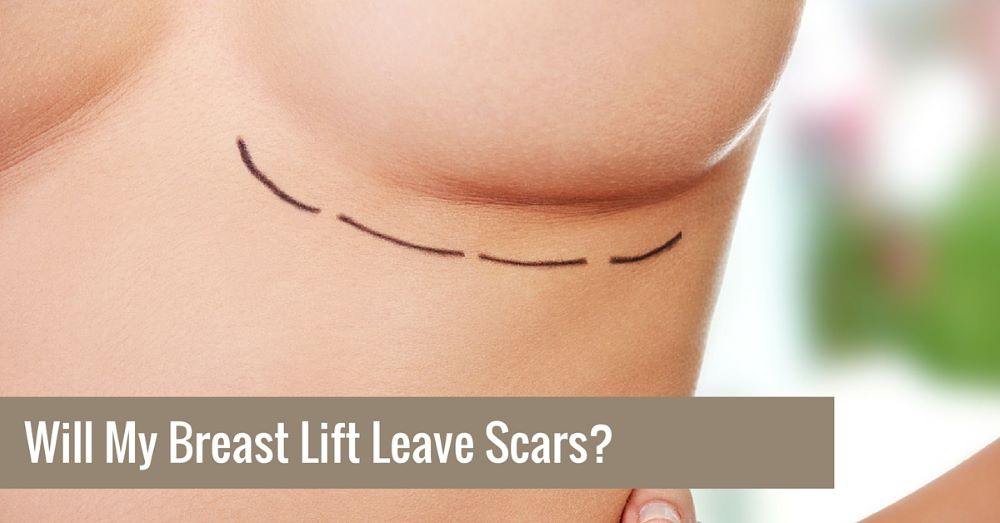Women are twice as likely to get a breast lift than a breast augmentation. While a breast augmentation is meant to enlarge breasts, more women are opting for breast lift surgery (mastopexy) to restore a firmer, perkier, and more aesthetically pleasing shape to sagging breasts.
Will My Breast Lift Leave Scars?
One of the most worrisome aspects of breast lift surgery for most patients is the potential for noticeable scarring. As a procedure designed to improve the aesthetic look of your body, a poorly performed procedure can end up leaving noticeable marks, typically under the breast. Fortunately, advancements in technology during and after the procedure have reduced greatly the risk of scarring that’s noticeable.
So, is the idea of a scar the only consideration standing between you and a breast lift?
Once you see how this cosmetic surgery procedure can enhance a woman’s shape, you might not worry much about the breast lift scars. Any procedure that involves surgical incision, like a lift or breast implants, leaves scars, but they will fade with time.
Dealing with Scarring and What Are the Realistic Outcomes
Despite the benefits, the risk of scarring is an issue that may keep many women who are considering a lift from undergoing the surgery. Unfortunately, the fact is that any surgery, no matter how major or minor, will cause some degree of scarring. Some more so than others, but there is no such thing as a scar-free surgery.
However, minimizing the appearance of breast lift scars will be of vital importance to your plastic surgeon. The whole point of a breast lift procedure is to make the breast more attractive, and conspicuous or heavy scarring defeats that point. Most breast lift scars will typically heal and fade within two years, but will always be present. Your surgeon will consider it a part of their job to keep these surgical scars discrete, not a bonus. They may also prescribe cortisone cream and use silicone sheeting to help reduce the appearance of scar tissue after surgery.
Related: Breast Lift Recovery Timeline and Healing Process
You will be under the care of professionals.Types of Scarring After Surgery
There exist a multitude of scarring types that the human body undergoes when healing from trauma that takes place on the skin. For those undergoing surgery, there are three types that may occur:
1. Keloid Scarring – This type of scarring would only be the result of a procedure that causes an unusual amount of damage to the skin. This type of scarring is essentially “aggressive healing,” as the body sends excessive amounts of collagen to the area in an attempt to fix the skin.For a portion of the population, keloid scarring occurs even for relatively minor procedures and wounds, leading to the area of the skin becoming red, raised and slightly waxy. If you are prone to keloid scarring, tell your plastic surgeon before undergoing the procedure.
For a portion of the population, keloid scarring occurs even for relatively minor procedures and wounds, leading to the area of the skin becoming red, raised and slightly waxy. If you are prone to keloid scarring, tell your plastic surgeon before undergoing the procedure.
2. Atrophic Scarring – Unlike keloid scarring (which is slightly raised), atrophic scarring appears as a scar that forms a depression within the top layer of skin. This results in a reddened area of the skin that’s depressed, sometimes mistaken for hyperpigmentation.
3. Hypertrophic Scarring – Similar to keloid scarring, hypertrophic scarring appears as a section of the skin that’s elevated and slightly discoloured. Unlike keloid scarring, hypertrophic scars do not extend past the area of concern, making them less noticeable than keloid.
Impact of Breast Lift Surgery
Many women weigh the benefits against the risks of breast lift procedures, and decide to opt for the surgery anyway.
Among the benefits are an improved appearance, a reduction in the size of stretched areolae and more youthful, feminine proportions, which has the added benefit of helping bras and swimsuits fit more comfortably and attractively. The surgery ultimately hopes to make the breasts look better proportioned, after birth or simply to rectify the issues of aging.
“I feel more feminine, more comfortable in clothing, in a bathing suit—and in my naked body,” says 34-year-old Missy in an article published in Allure. Please consult our Breast Lift Procedure page to learn more, view before and after pictures, and decide if a breast lift is right for you.

Incision Types Impact Breast Lift Scars
There are a variety of breast lift incisions and each carry different levels of scarring. Unfortunately, you may not be able to take the option with the least amount of scarring, since each patient will have different needs.
The technique used for your procedure will also influence the appearance of your scars, so talk to your surgeon to get a complete explanation of the typical scarring associated with each breast lift incision technique, including the standard (anchor) breast lift surgery, doughnut mastopexy, and crescent lift techniques. Together, you can determine which option would work best in your particular case.
The “crescent lift” technique is mostly used for women who have a very small amount of sagging to correct, and involves one small incision that runs halfway around the top half of the edge of the areola. It’s usually only done when a patient is undergoing a breast augmentation, and even then only rarely. It’s more of a preventative measure, unlike the other options, which are focused on breasts that have more advanced sagging.
The peri-areolar or donut lift is more commonly used for minor sagging and implants, with very minor and easily hidden scarring that, again, runs around the areola.
The surgeries that risk more significant scarring are the much more common vertical or “lollipop” lift and the inverted T or “anchor” lift, which feature two and three incisions respectively. As they are more invasive surgeries than a crescent lift, you can expect more extensive scarring, but as long as you and your surgeon can provide proper care and observation, these can fade and can be easily hidden while you’re waiting for them to fade.
These are far more common than the crescent lift, and as such most surgeons and healthcare professionals are more experienced in post-surgery treatments and observation of the scars that develop.
It’s an unfortunate fact that any surgery will leave scars, but rest assured that they can be treated and will fade with time. Your surgeon is dedicated to making you look as good as possible, and will do everything in their power as your surgeon to minimize scarring and maximize your appeal.
Breast Lift Scar Treatments

Thankfully, there’s a slew of solutions that have been proven to help with scarring, even completely removing the visual effect. One of the first solutions that may be offered is a steroid injection into the area, which helps with the discomfort and redness of scarring. Cortisone creams are another option that may help to reduce the size of the blemish. Targeted cryotherapy, similar to the type of therapy used to remove warts, may also reduce scarring by freezing the tissue away.
Less severe treatments include silicone sheets or bandages, which meld with the scar to eliminate some of the thickness. Pressure bandages have also been shown to help make scars flatter. However, these types of solutions require daily diligence in order to work, sometimes requiring several months of consistent application to achieve results.
Your diet may also help to improve any scarring issues. Vitamin E supplements, combined with the consumption of healthy vegetables and fruits, unprocessed grains and meat.
Minimizing the Effects of Scarring
A fantastic plastic surgeon may be able to perform the procedure without noticeable scarring, which makes your doctor the first line of defense against disfigurement. Done properly, scars can be completely unnoticeable and hidden unless someone specifically looks for the incision.
If you do notice an unusual scar beginning to form, it’s best to approach your surgeon immediately with the issue. This way, a variety of solutions may be attempted to correct the issue.
Useful Resources About Breast Lifts
Looking for additional reading about breast lift surgery? We have also written the following blog posts about breast lifts, which may be helpful to you. Feel free to read the following blog posts:
- How to Prepare for Breast Lift Surgery
- How Long Does It Take To Recover After Breast Lift Surgery?
- Breast Lift Risks
If you are considering options for breast lift procedures, feel free to look at our Breast Lift Procedure page below:
Your Body, Your Decision

If you deal with the hassle of body-shaping clothes (such as underwire bras) on a daily basis, then you already understand why breast lift surgery is one of the most popular cosmetic surgical procedures. At The Royal Centre of Plastic Surgery, women choose to undergo this cosmetic enhancement to increase confidence and enhance the shape and appearance of their breasts.
Dr. Kenneth Dickie offers patients a personable approach to cutting-edge surgical and non-surgical procedures. We proudly offer plastic surgery services to Barrie, Collingwood, Sudbury, Orillia, Huntsville, Bracebridge and surrounding areas. Our plastic surgery private facility is located 40 minutes north of Toronto.
Schedule a personal consultation with plastic surgeon Dr. Kenneth Dickie. Or call us at the phone number posted at the top of the page.

